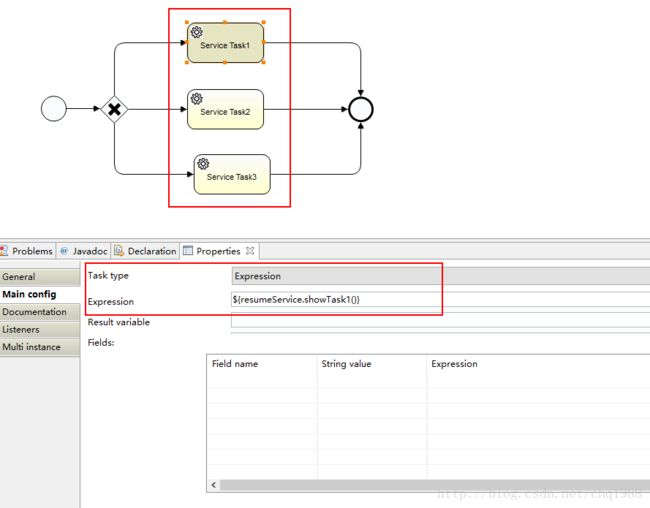- el-timeline时间线(Plus)左边图标改为自定义图片
顾尘眠
javascript前端vue.js
(目前图片有点小,还需要自己去调整下大概样式,比较懒,就放了个大概样子)时间线左侧正常根据文档内容,是填写的icon,但通过icon属性还有另外一个类型,component,可以搭配h函数写一组img元素,实现将图标改为本地图片{{activity.content}}import{h}from'vue'constactivities=[{content:'Eventstart',timestamp
- 迭代器模式 - Flutter中的集合导航专家,解锁数据遍历的无限可能!
明似水
flutter迭代器模式flutter
自定义滚动效果/树形结构遍历/分页加载…用迭代器掌控数据流动的节奏痛点场景:多源数据混合遍历假设你的社交应用需要显示以下内容:本地缓存的帖子新收到的实时消息推荐广告朋友动态这些数据来自不同接口,结构各异:ListcachedPosts=[...];StreamrealtimeMessages=[...];Listads=[...];Future>friendActivities=[...];传统遍
- BpmnJs源码篇2:diagram.js 简介与EventBus全局事件总线
MiyueFE
javascript前端vue
✨✨✨目前成都的"小学生"大佬和作者一起开发了Flowable流程引擎组件(包含前端设计器与后端流程引擎)详情请访问:https://www.bpmport.com/products。预览:Flowable编辑器:flowable-designer,Activiti编辑器:activiti-designer,预览与模拟:viewer,DMN决策设计器:dmndiagram.js简介作为bpmn.j
- Flowable02表结构--------------持续更新中
鱼见千寻
flowablejava前端servletspringbootflowable
那么根据上文我们已经将flowable引入springboot项目中去了,而flowable这个框架本质上来说就是对这60张表操作的封装。那么明白这60张表是干啥的对我们理解使用这个框架非常的有帮助。如下是这60多张表的具体解释,当然不需要全部记住,最下边会有比较重要表的总结,若是追求速成可直接看最后的核心关系。Flowable的表都以ACT_开头,这是沿用了其前身Activiti的命名习惯。表名
- ElementPlus表格相关操作大全-2
朝阳 Melo
前端javascript开发语言
网址:一个Vue3UI框架|ElementPlus(element-plus.org)https://element-plus.org/zh-CN/例:组件——Form表单典型表单参考代码:-OnlineactivitiesPromotionactivitiesOfflineactivitiesSimplebrandexposureSponsorVenueCreateCancelimport{re
- 流程管理系统技术选型避坑指南(含开源)
Alex艾力的IT数字空间
开源java网络中间件gitidevscode
一、开源流程引擎方案以下为基于BPMN2.0标准的开源方案,覆盖轻量级到企业级需求:引擎名称核心特点适用场景技术栈社区活跃度官网Camunda-完整BPMN/DMN/CMMN支持-可视化流程设计器-分布式架构支持高并发复杂业务流程(金融、制造业)Java/SpringBoot/微服务高camunda.comFlowable-Activiti分支,性能优化-支持云原生部署-与Spring生态深度集成
- Java ERP HRM终极指南:从代码到实战,10万行注释揭秘企业级开发(SSM框架+MySQL+Spring Security深度解析
墨夶
Java学习资料4javamysqlspring
**JavaERPHRM系统深度解析**1.系统架构与核心模块1.1系统架构图[用户请求]→SpringMVC控制器→Service层(业务逻辑)→MyBatis持久层→MySQL数据库1.2核心模块模块功能描述技术实现员工信息管理员工档案、职位、薪资管理SpringDataJPA+分页插件招聘管理简历筛选、面试安排、录用审批文件上传+工作流引擎(Activiti)绩效管理KPI设定、考核、改进计
- 【技术支持】Android11 中获取应用列表
daban2008
技术支持android-studioandroidjetpack
getInstalledApplications方式获取的比较杂乱,有时无法获取第三方应用建议使用queryIntentActivitiesPackageManagerpm=getPackageManager();//Listapps=pm.getInstalledApplications(PackageManager.GET_META_DATA);Intentintent=newIntent(I
- Activiti基础学习之入门代码(04)
PP东
Java学习java
这里写目录标题一、流程定义二、压缩包部署方式2.1将holiday.bpmn和holiday.png压缩成zip包。2.2查看数据表三、流程相关操作3.1流程定义查询3.2流程定义删除3.3流程定义资源查询3.3.1方式一3.3.2方式二3.4流程历史信息的查看一、流程定义流程定义是线下按照bpmn2.0标准去描述业务流程,通常使用activiti-explorer(web控制台)或activit
- 工作流引擎-12-开源 BPM 项目 foxbpm
老马啸西风
web开源ERPBPMOAactivitiworkflowflowable
工作流引擎系列工作流引擎-00-流程引擎概览工作流引擎-01-Activiti是领先的轻量级、以Java为中心的开源BPMN引擎,支持现实世界的流程自动化需求工作流引擎-02-BPMOAERP区别和联系工作流引擎-03-聊一聊流程引擎工作流引擎-04-流程引擎activiti优秀开源项目工作流引擎-05-流程引擎Camunda8协调跨人、系统和设备的复杂业务流程工作流引擎-06-流程引擎Flowa
- android adb 常见命令
renjiemei
androidadb
查看应用内存:adbshelldumpsysmeminfo查看当前页面activity:adbshell"dumpsysactivitytop|grepACTIVITY或者adbshelldumpsysactivitytop|findstradbshelldumpsysactivityactivities|findstr|findstrRun当前可见fragment:adbshell"dumpsy
- java OA项目源码 flowable activiti流程引擎 Springboot html vue.js 前后分离
FH-Admin
springbootflowablespringbootjavaspringcloud
1.模型管理:web在线流程设计器、预览流程xml、导出xml、部署流程2.流程管理:导入导出流程资源文件、查看流程图、根据流程实例反射出流程模型、激活挂起、自由跳转3.运行中流程:查看流程信息、当前任务节点、当前流程图、作废暂停流程、指派待办人4.历史的流程:查看流程信息、流程用时、流程状态、查看任务发起人信息5.待办任务:查看本人个人任务以及本角色下的任务、办理、驳回、作废、指派一下代理人6.
- 工作流引擎-18-开源审批流项目之 plumdo-work 工作流,表单,报表结合的多模块系统
老马啸西风
web开源vue.jsflowableworkflowactivitiBPMOA
工作流引擎系列工作流引擎-00-流程引擎概览工作流引擎-01-Activiti是领先的轻量级、以Java为中心的开源BPMN引擎,支持现实世界的流程自动化需求工作流引擎-02-BPMOAERP区别和联系工作流引擎-03-聊一聊流程引擎工作流引擎-04-流程引擎activiti优秀开源项目工作流引擎-05-流程引擎Camunda8协调跨人、系统和设备的复杂业务流程工作流引擎-06-流程引擎Flowa
- 工作流引擎-13-开源 BPM 项目 UFLO2
老马啸西风
web开源ERPOABPMactivitiworkflowflowable
工作流引擎系列工作流引擎-00-流程引擎概览工作流引擎-01-Activiti是领先的轻量级、以Java为中心的开源BPMN引擎,支持现实世界的流程自动化需求工作流引擎-02-BPMOAERP区别和联系工作流引擎-03-聊一聊流程引擎工作流引擎-04-流程引擎activiti优秀开源项目工作流引擎-05-流程引擎Camunda8协调跨人、系统和设备的复杂业务流程工作流引擎-06-流程引擎Flowa
- 工作流引擎-08-流程引擎(Process Engine) flowable-engine 优秀开源项目
老马啸西风
web开源ERPOABPMactivitiworkflowflowable
工作流引擎系列工作流引擎-00-流程引擎概览工作流引擎-01-Activiti是领先的轻量级、以Java为中心的开源BPMN引擎,支持现实世界的流程自动化需求工作流引擎-02-BPMOAERP区别和联系工作流引擎-03-聊一聊流程引擎工作流引擎-04-流程引擎activiti优秀开源项目工作流引擎-05-流程引擎Camunda8协调跨人、系统和设备的复杂业务流程工作流引擎-06-流程引擎Flowa
- 工作流引擎-10-什么是 BPM?
老马啸西风
web开源activitiworkflowbpmOA
工作流引擎系列工作流引擎-00-流程引擎概览工作流引擎-01-Activiti是领先的轻量级、以Java为中心的开源BPMN引擎,支持现实世界的流程自动化需求工作流引擎-02-BPMOAERP区别和联系工作流引擎-03-聊一聊流程引擎工作流引擎-04-流程引擎activiti优秀开源项目工作流引擎-05-流程引擎Camunda8协调跨人、系统和设备的复杂业务流程工作流引擎-06-流程引擎Flowa
- 工作流引擎-04-流程引擎(Process Engine)activiti 优秀开源项目
老马啸西风
web开源activitiworkflowbpmOA
工作流引擎系列工作流引擎-00-流程引擎概览工作流引擎-01-Activiti是领先的轻量级、以Java为中心的开源BPMN引擎,支持现实世界的流程自动化需求工作流引擎-02-BPMOAERP区别和联系工作流引擎-03-聊一聊流程引擎工作流引擎-04-流程引擎activiti优秀开源项目工作流引擎-05-流程引擎Camunda8协调跨人、系统和设备的复杂业务流程工作流引擎-06-流程引擎Flowa
- 工作流引擎 Warm Flow 加入 Dromara 开源社区
晓华-warm
warm-flow开源
作者介绍名称:warmdromara开源组织成员,dromara/warm-flow作者研发工程师、技术经理,工作经验8年。此工作流已经持续开发有一年有余。Gitee|Github微信:warm-houhou;qq群:778470567历史背景flowable和activities确实大而全,但是这样对一般的项目会是好事吗?能早点下班吗学习曲线:对于初学者来说,学习可能需要一定的时间和精力。理解其
- 整合Acitiviti在线流程设计器(Activiti-Modeler 5.18.0)
BPM发掘者
企业开发saas云计算企业应用流程管理开发模式
1.概述前言在国内的企业办公、企业业务管理、流程管理等业务要求中,我们都需要一块流程的业务管理设计工具,特别是面向BPMN2标准的,ActivitiModeler刚好就是这样一款不错的设计工具,而本文则描述如何把它整合到我们自身的系统中去。如下我们来看一下其整合后的效果,可以看得出其支持丰富的BPMN元素。2.整合Activiti-Modeler的要求Activiti-Modeler5.18用了新
- Android面试问答题总结
qq_孤小狼
android面试
1.什么是Activity?四大组件之一,一般的,一个用户交互界面对应一个activitysetContentView(),//要显示的布局button.setOnclickLinstener{},activity是Context的子类,同时实现了window.callback和keyevent.callback,可以处理与窗体用户交互的事件.我开发常用的的有FragmentActivitiy,L
- Flowable 概述:轻量级开源工作流引擎的技术解析
艾斯比的日常
开源
Flowable简介:轻量级开源工作流引擎的技术解析一、Flowable概述Flowable是基于Apache2.0协议的开源工作流引擎,专注于提供轻量级、高性能的业务流程管理解决方案。它支持完整的BPMN2.0规范,提供从流程建模、执行到监控的全生命周期管理能力。作为Activiti项目的分支,Flowable在保持原有功能的基础上,通过优化架构和社区协作,成为企业级流程管理的首选方案之一。核心
- 工作流引擎-03-聊一聊什么是流程引擎(Process Engine)?
老马啸西风
webERPBPMOAactivitiworkflow
前言大家好,我是老马。最近想设计一款审批系统,于是了解一下关于流程引擎的知识。下面是一些的流程引擎相关资料。工作流引擎系列工作流引擎-00-流程引擎概览工作流引擎-01-Activiti是领先的轻量级、以Java为中心的开源BPMN引擎,支持现实世界的流程自动化需求工作流引擎-02-BPMOAERP区别和联系工作流引擎-03-聊一聊流程引擎工作流引擎-04-流程引擎activiti优秀开源项目工作
- 工作流引擎-02-BPM OA ERP 区别和联系
老马啸西风
webbpmerpOA流程引擎工作流引擎activitiworkflow
前言大家好,我是老马。最近想设计一款审批系统,于是了解一下关于流程引擎的知识。下面是一些的流程引擎相关资料。工作流引擎系列工作流引擎-00-流程引擎概览工作流引擎-01-Activiti是领先的轻量级、以Java为中心的开源BPMN引擎,支持现实世界的流程自动化需求工作流引擎-02-BPMOAERP区别和联系工作流引擎-03-聊一聊流程引擎工作流引擎-04-流程引擎activiti优秀开源项目工作
- 工作流引擎-01-Activiti 是领先的轻量级、以 Java 为中心的开源 BPMN 引擎,支持现实世界的流程自动化需求
老马啸西风
java开源自动化workflowflowableactivitiBPM
前言大家好,我是老马。最近想设计一款审批系统,于是了解一下关于流程引擎的知识。下面是一些的流程引擎相关资料。工作流引擎系列工作流引擎-00-流程引擎概览工作流引擎-01-Activiti是领先的轻量级、以Java为中心的开源BPMN引擎,支持现实世界的流程自动化需求工作流引擎-02-BPMOAERP区别和联系工作流引擎-03-聊一聊流程引擎工作流引擎-04-流程引擎activiti优秀开源项目工作
- Activiti 如何在本地部署运用
不想做测试的工程师
Activitijava
Activiti在本地部署和运用的完整指南Activiti是一个轻量级的开源工作流和业务流程管理(BPM)引擎,下面我将详细介绍如何在本地环境中部署和运用Activiti。一、环境准备1.系统要求JDK8或更高版本Maven3.x数据库(支持H2、MySQL、PostgreSQL、Oracle等)IDE(如IntelliJIDEA或Eclipse)2.添加Maven依赖org.activitiac
- Programming Project TK3163
后端
ProgrammingProjectTK3163April2025Thisassignmenthas6activities:UploadandinstallJflexandreadthemanualofJFLex.I.URLforJFLexinstallation:https://jflex.de/download.htmlII.OnceyouhavedownloadedJFlex,unzipth
- Python, C ++ are used to develop the app of “how to organize the activities ”
Geeker-2025
pythonc++
Here'satechnicalblueprintforanactivityorganizationappcombiningPythonandC++:#ActivityOrganizationAppArchitecture##SystemOverview```mermaidgraphTDA[PythonLayer]-->B{CoreEngine}C[C++Layer]-->BB-->D[UserI
- Error querying database. Cause: java.sql.SQLSyntaxErrorException: Table ‘activiti.act_ge_property‘
晓强-
exceptionmysqlactiviti数据库jdbcjava
完整报错信息org.apache.ibatis.exceptions.PersistenceException:###Errorqueryingdatabase.Cause:java.sql.SQLSyntaxErrorException:Table'activiti.act_ge_property'doesn'texist###Theerrormayexistinorg/activiti/db/
- 香橙派zero3 安卓TV12,更换桌面launcher,开机自启动kodi
泰洋睿兔
香橙派android香橙派
打开开发者模式,连击版本号,基本上都是这样。adb连接查找桌面包名adbshelldumpsysactivityactivities|findstrmResumedActivity禁用原桌面com.android.tv.launcher,已经安装了projectivylauncher434.apk桌面。adbshellpmdisable-usercom.android.tv.launcher还安装
- 金仓数据库KingbaseES产品支持框架
沉舟侧畔千帆过_
数据库金仓数据库kingbase.net
1.ActivitiActiviti是一个覆盖了业务流程管理、工作流、服务协作等领域的开源的、灵活的、易扩展的可执行流程语言框架。KingbaseES已兼容至Activiti7。 Activiti的jar包及其依赖包可以从官方网站下载,也可以通过maven导入。KingbaseES有两种形态的驱动包:(推荐)Postgre形态:postgresql-42.2.9.jar,无需配置,替换后修改连接
- 设计模式介绍
tntxia
设计模式
设计模式来源于土木工程师 克里斯托弗 亚历山大(http://en.wikipedia.org/wiki/Christopher_Alexander)的早期作品。他经常发表一些作品,内容是总结他在解决设计问题方面的经验,以及这些知识与城市和建筑模式之间有何关联。有一天,亚历山大突然发现,重复使用这些模式可以让某些设计构造取得我们期望的最佳效果。
亚历山大与萨拉-石川佳纯和穆雷 西乐弗斯坦合作
- android高级组件使用(一)
百合不是茶
androidRatingBarSpinner
1、自动完成文本框(AutoCompleteTextView)
AutoCompleteTextView从EditText派生出来,实际上也是一个文本编辑框,但它比普通编辑框多一个功能:当用户输入一个字符后,自动完成文本框会显示一个下拉菜单,供用户从中选择,当用户选择某个菜单项之后,AutoCompleteTextView按用户选择自动填写该文本框。
使用AutoCompleteTex
- [网络与通讯]路由器市场大有潜力可挖掘
comsci
网络
如果国内的电子厂商和计算机设备厂商觉得手机市场已经有点饱和了,那么可以考虑一下交换机和路由器市场的进入问题.....
这方面的技术和知识,目前处在一个开放型的状态,有利于各类小型电子企业进入
&nbs
- 自写简单Redis内存统计shell
商人shang
Linux shell统计Redis内存
#!/bin/bash
address="192.168.150.128:6666,192.168.150.128:6666"
hosts=(${address//,/ })
sfile="staticts.log"
for hostitem in ${hosts[@]}
do
ipport=(${hostitem
- 单例模式(饿汉 vs懒汉)
oloz
单例模式
package 单例模式;
/*
* 应用场景:保证在整个应用之中某个对象的实例只有一个
* 单例模式种的《 懒汉模式》
* */
public class Singleton {
//01 将构造方法私有化,外界就无法用new Singleton()的方式获得实例
private Singleton(){};
//02 申明类得唯一实例
priva
- springMvc json支持
杨白白
json springmvc
1.Spring mvc处理json需要使用jackson的类库,因此需要先引入jackson包
2在spring mvc中解析输入为json格式的数据:使用@RequestBody来设置输入
@RequestMapping("helloJson")
public @ResponseBody
JsonTest helloJson() {
- android播放,掃描添加本地音頻文件
小桔子
最近幾乎沒有什麽事情,繼續鼓搗我的小東西。想在項目中加入一個簡易的音樂播放器功能,就像華為p6桌面上那麼大小的音樂播放器。用過天天動聽或者QQ音樂播放器的人都知道,可已通過本地掃描添加歌曲。不知道他們是怎麼實現的,我覺得應該掃描設備上的所有文件,過濾出音頻文件,每個文件實例化為一個實體,記錄文件名、路徑、歌手、類型、大小等信息。具體算法思想,
- oracle常用命令
aichenglong
oracledba常用命令
1 创建临时表空间
create temporary tablespace user_temp
tempfile 'D:\oracle\oradata\Oracle9i\user_temp.dbf'
size 50m
autoextend on
next 50m maxsize 20480m
extent management local
- 25个Eclipse插件
AILIKES
eclipse插件
提高代码质量的插件1. FindBugsFindBugs可以帮你找到Java代码中的bug,它使用Lesser GNU Public License的自由软件许可。2. CheckstyleCheckstyle插件可以集成到Eclipse IDE中去,能确保Java代码遵循标准代码样式。3. ECLemmaECLemma是一款拥有Eclipse Public License许可的免费工具,它提供了
- Spring MVC拦截器+注解方式实现防止表单重复提交
baalwolf
spring mvc
原理:在新建页面中Session保存token随机码,当保存时验证,通过后删除,当再次点击保存时由于服务器端的Session中已经不存在了,所有无法验证通过。
1.新建注解:
? 1 2 3 4 5 6 7 8 9 10 11 12 13 14 15 16 17 18
- 《Javascript高级程序设计(第3版)》闭包理解
bijian1013
JavaScript
“闭包是指有权访问另一个函数作用域中的变量的函数。”--《Javascript高级程序设计(第3版)》
看以下代码:
<script type="text/javascript">
function outer() {
var i = 10;
return f
- AngularJS Module类的方法
bijian1013
JavaScriptAngularJSModule
AngularJS中的Module类负责定义应用如何启动,它还可以通过声明的方式定义应用中的各个片段。我们来看看它是如何实现这些功能的。
一.Main方法在哪里
如果你是从Java或者Python编程语言转过来的,那么你可能很想知道AngularJS里面的main方法在哪里?这个把所
- [Maven学习笔记七]Maven插件和目标
bit1129
maven插件
插件(plugin)和目标(goal)
Maven,就其本质而言,是一个插件执行框架,Maven的每个目标的执行逻辑都是由插件来完成的,一个插件可以有1个或者几个目标,比如maven-compiler-plugin插件包含compile和testCompile,即maven-compiler-plugin提供了源代码编译和测试源代码编译的两个目标
使用插件和目标使得我们可以干预
- 【Hadoop八】Yarn的资源调度策略
bit1129
hadoop
1. Hadoop的三种调度策略
Hadoop提供了3中作业调用的策略,
FIFO Scheduler
Fair Scheduler
Capacity Scheduler
以上三种调度算法,在Hadoop MR1中就引入了,在Yarn中对它们进行了改进和完善.Fair和Capacity Scheduler用于多用户共享的资源调度
2. 多用户资源共享的调度
- Nginx使用Linux内存加速静态文件访问
ronin47
Nginx是一个非常出色的静态资源web服务器。如果你嫌它还不够快,可以把放在磁盘中的文件,映射到内存中,减少高并发下的磁盘IO。
先做几个假设。nginx.conf中所配置站点的路径是/home/wwwroot/res,站点所对应文件原始存储路径:/opt/web/res
shell脚本非常简单,思路就是拷贝资源文件到内存中,然后在把网站的静态文件链接指向到内存中即可。具体如下:
- 关于Unity3D中的Shader的知识
brotherlamp
unityunity资料unity教程unity视频unity自学
首先先解释下Unity3D的Shader,Unity里面的Shaders是使用一种叫ShaderLab的语言编写的,它同微软的FX文件或者NVIDIA的CgFX有些类似。传统意义上的vertex shader和pixel shader还是使用标准的Cg/HLSL 编程语言编写的。因此Unity文档里面的Shader,都是指用ShaderLab编写的代码,然后我们来看下Unity3D自带的60多个S
- CopyOnWriteArrayList vs ArrayList
bylijinnan
java
package com.ljn.base;
import java.util.ArrayList;
import java.util.Iterator;
import java.util.List;
import java.util.concurrent.CopyOnWriteArrayList;
/**
* 总述:
* 1.ArrayListi不是线程安全的,CopyO
- 内存中栈和堆的区别
chicony
内存
1、内存分配方面:
堆:一般由程序员分配释放, 若程序员不释放,程序结束时可能由OS回收 。注意它与数据结构中的堆是两回事,分配方式是类似于链表。可能用到的关键字如下:new、malloc、delete、free等等。
栈:由编译器(Compiler)自动分配释放,存放函数的参数值,局部变量的值等。其操作方式类似于数据结构中
- 回答一位网友对Scala的提问
chenchao051
scalamap
本来准备在私信里直接回复了,但是发现不太方便,就简要回答在这里。 问题 写道 对于scala的简洁十分佩服,但又觉得比较晦涩,例如一例,Map("a" -> List(11,111)).flatMap(_._2),可否说下最后那个函数做了什么,真正在开发的时候也会如此简洁?谢谢
先回答一点,在实际使用中,Scala毫无疑问就是这么简单。
- mysql 取每组前几条记录
daizj
mysql分组最大值最小值每组三条记录
一、对分组的记录取前N条记录:例如:取每组的前3条最大的记录 1.用子查询: SELECT * FROM tableName a WHERE 3> (SELECT COUNT(*) FROM tableName b WHERE b.id=a.id AND b.cnt>a. cnt) ORDER BY a.id,a.account DE
- HTTP深入浅出 http请求
dcj3sjt126com
http
HTTP(HyperText Transfer Protocol)是一套计算机通过网络进行通信的规则。计算机专家设计出HTTP,使HTTP客户(如Web浏览器)能够从HTTP服务器(Web服务器)请求信息和服务,HTTP目前协议的版本是1.1.HTTP是一种无状态的协议,无状态是指Web浏览器和Web服务器之间不需要建立持久的连接,这意味着当一个客户端向服务器端发出请求,然后We
- 判断MySQL记录是否存在方法比较
dcj3sjt126com
mysql
把数据写入到数据库的时,常常会碰到先要检测要插入的记录是否存在,然后决定是否要写入。
我这里总结了判断记录是否存在的常用方法:
sql语句: select count ( * ) from tablename;
然后读取count(*)的值判断记录是否存在。对于这种方法性能上有些浪费,我们只是想判断记录记录是否存在,没有必要全部都查出来。
- 对HTML XML的一点认识
e200702084
htmlxml
感谢http://www.w3school.com.cn提供的资料
HTML 文档中的每个成分都是一个节点。
节点
根据 DOM,HTML 文档中的每个成分都是一个节点。
DOM 是这样规定的:
整个文档是一个文档节点
每个 HTML 标签是一个元素节点
包含在 HTML 元素中的文本是文本节点
每一个 HTML 属性是一个属性节点
注释属于注释节点
Node 层次
- jquery分页插件
genaiwei
jqueryWeb前端分页插件
//jquery页码控件// 创建一个闭包 (function($) { // 插件的定义 $.fn.pageTool = function(options) { var totalPa
- Mybatis与Ibatis对照入门于学习
Josh_Persistence
mybatisibatis区别联系
一、为什么使用IBatis/Mybatis
对于从事 Java EE 的开发人员来说,iBatis 是一个再熟悉不过的持久层框架了,在 Hibernate、JPA 这样的一站式对象 / 关系映射(O/R Mapping)解决方案盛行之前,iBaits 基本是持久层框架的不二选择。即使在持久层框架层出不穷的今天,iBatis 凭借着易学易用、
- C中怎样合理决定使用那种整数类型?
秋风扫落叶
c数据类型
如果需要大数值(大于32767或小于32767), 使用long 型。 否则, 如果空间很重要 (如有大数组或很多结构), 使用 short 型。 除此之外, 就使用 int 型。 如果严格定义的溢出特征很重要而负值无关紧要, 或者你希望在操作二进制位和字节时避免符号扩展的问题, 请使用对应的无符号类型。 但是, 要注意在表达式中混用有符号和无符号值的情况。
&nbs
- maven问题
zhb8015
maven问题
问题1:
Eclipse 中 新建maven项目 无法添加src/main/java 问题
eclipse创建maevn web项目,在选择maven_archetype_web原型后,默认只有src/main/resources这个Source Floder。
按照maven目录结构,添加src/main/ja
- (二)androidpn-server tomcat版源码解析之--push消息处理
spjich
javaandrodipn推送
在 (一)androidpn-server tomcat版源码解析之--项目启动这篇中,已经描述了整个推送服务器的启动过程,并且把握到了消息的入口即XmppIoHandler这个类,今天我将继续往下分析下面的核心代码,主要分为3大块,链接创建,消息的发送,链接关闭。
先贴一段XmppIoHandler的部分代码
/**
* Invoked from an I/O proc
- 用js中的formData类型解决ajax提交表单时文件不能被serialize方法序列化的问题
中华好儿孙
JavaScriptAjaxWeb上传文件FormData
var formData = new FormData($("#inputFileForm")[0]);
$.ajax({
type:'post',
url:webRoot+"/electronicContractUrl/webapp/uploadfile",
data:formData,
async: false,
ca
- mybatis常用jdbcType数据类型
ysj5125094
mybatismapperjdbcType
MyBatis 通过包含的jdbcType
类型
BIT FLOAT CHAR



